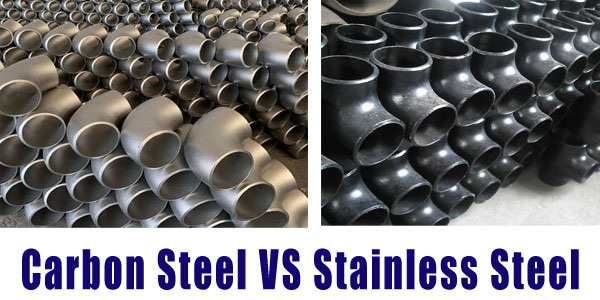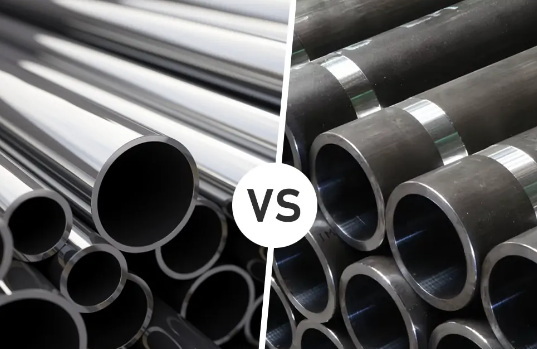English


Views: 222 Author: Tomorrow Publish Time: 2025-07-18 Origin: Site











Content Menu
● Understanding Stainless Steel and Carbon Steel
● Chemical Composition and Impact on Fabrication
● Fabrication Process Differences
● Corrosion and Surface Finish
● Environmental and Maintenance Factors
● Sustainability and Recyclability
● FAQ
>> 1. What is the main difference between stainless steel and carbon steel?
>> 2. Which steel is better for outdoor construction?
>> 3. Is carbon steel easier to weld than stainless steel?
>> 4. Why is stainless steel more expensive than carbon steel?
>> 5. Can carbon steel be used in food processing applications?
Steel fabrication plays a critical role in various industries, from construction and automotive to aerospace and manufacturing. When choosing the right material for a project, two common options are stainless steel and carbon steel. While both are steel alloys, their properties, applications, and fabrication processes differ significantly. This article explores the key differences between stainless steel fabrication and carbon steel fabrication, providing insights to help you make an informed choice.

Stainless steel is an alloy primarily composed of iron, chromium, and usually nickel, along with other trace elements. The chromium content, generally above 10.5%, creates a thin, stable oxide layer that protects the steel from corrosion and rust, giving stainless steel its signature resistance and shiny appearance. This oxide layer is self-healing, which means even if the surface is scratched, the chromium reacts with oxygen to regenerate the protective film—preventing further degradation. Stainless steel also resists staining, rust, and tarnishing, which makes it ideal for environments where cleanliness and aesthetics matter.
Carbon steel is primarily composed of iron and carbon, with carbon content typically ranging from 0.12% to 2.0%. The carbon content substantially influences its characteristics, including hardness, strength, ductility, and malleability. Unlike stainless steel, carbon steel lacks significant chromium and nickel, meaning it is much more susceptible to corrosion and rust without adequate protection. However, carbon steel is prized for its strength and cost-effectiveness, and its varying carbon levels enable a wide range of mechanical properties—from soft, ductile mild steels to hard, wear-resistant tool steels.
The differing chemical compositions of stainless steel and carbon steel result in distinct fabrication considerations.
| Property | Stainless Steel | Carbon Steel |
|---|---|---|
| Main Alloying Elements | Iron, Chromium (≥10.5%), Nickel | Iron, Carbon (0.12% to 2.0%) |
| Corrosion Resistance | High (due to chromium oxide layer) | Low (prone to rust without coating) |
| Strength | High tensile strength due to alloys | Varies with carbon content |
| Ductility | More ductile (especially with nickel) | Less ductile as carbon increases |
| Cost | More expensive | Generally less expensive |
The chromium and nickel in stainless steel form a natural protective barrier that prevents rust, essential for fabrications in harsh environments or those requiring hygiene. Carbon steel's simpler alloy composition enhances hardness and machinability, especially with higher carbon levels, but corrodes easily without protective treatment.
- Carbon Steel: Its lower alloy complexity allows for easier machining and welding. Mild carbon steels tend to be more forgiving, flexible, and weld well with standard processes. Higher carbon steels are harder and stronger but may be more brittle and require pre-heat treatment or post-weld heat treatment to relieve stresses.
- Stainless Steel: The presence of chromium and nickel increases strength and hardness, requiring specialized welding techniques such as TIG (Tungsten Inert Gas) or MIG (Metal Inert Gas) welding with shielding gases to prevent oxidation and contamination. Stainless steel also has lower thermal conductivity than carbon steel, meaning heat dissipates less rapidly during welding, increasing the risk of warping or distortion if not carefully managed.
- Carbon Steel: More malleable, particularly in low to medium carbon grades, allowing easier bending, shaping, and forming without cracking. This is why carbon steel is favored in structural elements that require significant forming.
- Stainless Steel: While generally ductile, stainless steel tends to resist deformation more than mild carbon steel, with higher spring back after forming. This requires careful planning and sometimes additional forming steps to achieve the desired shape. However, it tends to retain its shape well once the desired form is achieved.
Both stainless steel and carbon steel benefit from heat treatment but with distinct purposes:
- Carbon Steel: Heat treatment is commonly used to increase hardness, strength, and wear resistance or to improve machinability and toughness. Various treatments like annealing, quenching, and tempering are regularly applied.
- Stainless Steel: Heat treatment can optimize corrosion resistance and mechanical properties. Some stainless steel grades are precipitation hardened, while others are solution annealed to balance hardness and ductility.
One of the most important distinctions between stainless steel and carbon steel lies in their corrosion behavior and surface finish.
- Stainless Steel: Naturally corrosion-resistant due to the chromium oxide layer, stainless steel maintains a lustrous, often reflective finish. It withstands harsh environments like seawater, chemical exposure, and extreme temperatures while preventing rust. Stainless steel can also be polished to various finishes, making it desirable for applications requiring aesthetics or hygiene, including kitchen equipment and medical tools.
- Carbon Steel: Typically has a matte grey finish unless surface treated. It is prone to oxidation (rust) when exposed to moisture and air. To combat this, carbon steel often requires coatings such as galvanization, painting, or powder coating to protect the surface. Without such protection, carbon steel will corrode much faster, impacting structural integrity and appearance.

The mechanical performance of stainless steel and carbon steel varies depending on grade and treatment.
- Carbon Steel: Higher carbon content increases hardness and tensile strength while reducing ductility and toughness. High carbon steels are often used in cutting tools and wear-resistant machinery parts. Lower carbon steels provide a good balance of strength, ductility, and weldability for general fabrication.
- Stainless Steel: Offers excellent tensile strength combined with remarkable toughness and resistance to temperature changes. Many stainless steel grades perform well in both cryogenic and high-temperature conditions without losing strength or becoming brittle.
Cost plays a critical role in material selection.
- Carbon Steel: Generally less expensive material-wise and fabrication-wise due to simpler alloying, greater availability, and easier machining and welding. Its widespread use in construction and manufacturing is due largely to its cost-effectiveness.
- Stainless Steel: Costs more due to the alloying elements chromium and nickel, as well as the need for specialized fabrication techniques and slower machining speeds. However, stainless steel's longer lifespan and lower maintenance requirements can result in lower life-cycle costs, especially in corrosive or hygienic environments.
| Application Area | Stainless Steel Fabrication | Carbon Steel Fabrication |
|---|---|---|
| Construction | Used for architectural facades, railing, and infrastructure requiring corrosion resistance | Widely used in structural frames, beams, and reinforcements where corrosion is less critical |
| Food and Medical | Equipment, kitchen utensils, sanitary pipes | Rarely used due to corrosion risk |
| Automotive and Machinery | Exhaust systems, decorative trims | Engine parts, chassis components |
| Cutlery and Tools | Less common for hardened cutting tools | High carbon steels preferred for knives and cutting blades |
| Storage Tanks & Pipelines | Excellent for corrosive or high-hygiene environments | Used where cost and strength priority override corrosion concerns |
Stainless steel fabrication is particularly advantageous in environments exposed to moisture, chemicals, saltwater, or temperature extremes, as it requires minimal protective coatings and maintenance over its service life. Carbon steel, while offering strength and versatility, often necessitates routine inspections and repainting or galvanizing to extend service life and prevent corrosion-related failures.
In environmentally sensitive industries such as food processing and pharmaceuticals, stainless steel's ability to withstand frequent cleaning and sterilization without degrading is critical. Carbon steel is generally unsuitable where hygiene and contamination control are top priorities.
Both stainless steel and carbon steel are recyclable materials, contributing to sustainable manufacturing practices. Stainless steel, with its longer lifespan and lower maintenance demands, can offer environmental benefits by reducing resource consumption and waste from corrosion or replacement.
Choosing between stainless steel fabrication and carbon steel fabrication depends chiefly on application requirements, environmental exposure, mechanical strength needs, and budget considerations. Stainless steel excels in corrosion resistance, aesthetic appeal, and durability, making it suitable for visible, hygienic, or corrosive environments despite higher costs. Carbon steel provides excellent strength, formability, and cost-effectiveness, ideal for structural and industrial purposes where corrosion can be managed or is less critical.
Understanding the differences in composition, fabrication processes, cost, and durability helps engineers, fabricators, and decision-makers select the right steel type for their projects, ensuring optimized performance, longevity, and value.

The primary difference lies in their chemical composition. Stainless steel contains chromium and often nickel, providing corrosion resistance, while carbon steel mainly contains iron and carbon, which affects hardness and strength but is less corrosion-resistant.
Stainless steel is better for outdoor construction because it resists rust and corrosion in exposure to weather elements. Carbon steel requires protective coatings to prevent degradation outdoors.
Yes, carbon steel generally welds easier due to its simpler alloy composition, while stainless steel requires specialized welding techniques to avoid issues like warping and corrosion at welded joints.
Stainless steel's higher cost results from its alloying elements like chromium and nickel, which improve corrosion resistance and durability but increase material and fabrication costs.
Carbon steel is less suitable for food processing due to its susceptibility to corrosion and difficulty in maintaining hygiene. Stainless steel is preferred because it is corrosion-resistant and easy to clean.
Welding Vs Stainless Steel Fabrication: Understanding The Manufacturing Process Differences
Stainless Steel Fabrication Vs Powder Coated Steel: Durability And Cost Comparison
CNC Machining Vs Stainless Steel Fabrication: Pros And Cons for Industrial Use
Stainless Steel Fabrication Vs Carbon Steel Fabrication: Key Differences Explained
Stainless Steel Fabrication Vs Aluminum Fabrication: Which Is Right for Your Project?
Stainless Steel Grades 201 Vs 304: Cost Vs Performance Breakdown
316L Vs 316 Stainless Steel Grades: Which Is Better for Corrosion Resistance?
Comparing Austenitic Vs Martensitic Stainless Steel Grades: What You Need To Know?
Stainless Steel 430 Vs 304: Key Differences Explained for Manufacturers
304 Vs 316 Stainless Steel Grades: Which One Suits Your Project Best?
